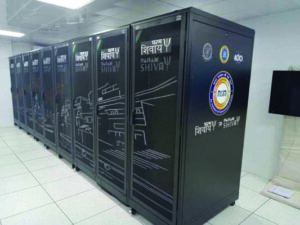NEW DELHI, OCT 13
Several premier academic institutions are partnering to establish an indigenous supercomputing infrastructure that will make India “future-ready” and help tackle challenges in various disciplines, the Department of Science and Technology said Tuesday.
The Centre for Development of Advanced Computing (C-DAC) under the Ministry of Electronics and Information Technology, in a virtual ceremony on Monday, signed 13 MoUs with the premier academic and R&D institutions to establish supercomputing infrastructure with assembly and manufacturing for the National Supercomputing Mission in the country.

The Rs 4,500-crore mission envisages empowering our national academic and R&D institutions to spread over the country by installing a vast supercomputing grid comprising more than 70 high-performance computing facilities, an official statement said.
It also includes the development of highly professional High-Performance Computing (HPC) aware human resource for meeting the challenges of the development of these applications.
The implementation of the mission will bring supercomputing within the reach of the large scientific and technology community in India and enable the country with a capacity to solve multi-disciplinary grand challenge problems.
The MoU was signed with a host of institutes like IISC Bangalore, IIT Kanpur, IIT Roorkee, IIT Hyderabad, IIT Guwahati, IIT Mandi, IIT Gandhinagar, NIT Trichy, NABI Mohali, and NSM Nodal Centres for training in HPC & AI at IIT Madras, IIT Kharagpur, IIT Goa, and IIT Palakkad.
Sanjay Dhotre, the Minister of State for Electronics and Information Technology, stressed that the MoU signing with the premier institutes marks the beginning of ”Aatmanirbhar Bharat”.
DST secretary Ashutosh Sharma mentioned that the signing of the 13 MoUs shows the speed that the mission has picked up, and it is a major boost to the computing facility.
“In the last 5 years, major changes took place in the mission where the emphasis was given on design and fabrication of hardware and software of the supercomputers in India,” he added.
Supercomputing is the key to so many areas like Computational Biology, Molecular Dynamics, National Security, Computational Chemistry, Cyber-Physical Systems, Big Data Analytics, Government Information Systems, Sharma noted.
“Armed with artificial intelligence and machine learning makes it a formidable tool. Progress in this mission will break silos to empower people and make India future-ready and tackle future challenges,” he added.
“Our goal is to develop indigenous hardware encompassing exascale chip design, design and manufacture exascale server boards, exascale interconnects and storage including silicon-photonics at C-DAC to achieve complete self-reliance,” C-DAC director-general Hemant Darbari said.
The mission is being implemented and steered jointly by the DST and the Department of Electronics and Information Technology for seven years to make India one of the world leaders in supercomputing.












